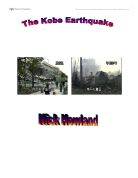Case Study: The Kobe earthquake
This assessment is about the Kobe earthquake in Japan and the effects of it. Kobe is on the island of Honshu in Japan. The earthquake was called the Great Hanshin Earthquake. An earthquake struck the city of Kobe on 17 January 1995 at 5:46am. The epicentre was on the northern part of Awaji Island (N34.36 E135.02). It depth was 16 kilometres below the earth's surface. The force of the earthquake was 7.3 on the Richter scale, 6 and 7 on the Japanese scale in different areas (Due to a review by the Meteorological Agency on April 23, 2001, magnitude was adjusted from 7.2). The ground motion was vertical and horizontal shaking occurring simultaneously.
Three crustal plates meet near to the coast of Japan. Close to Kobe, the bigger oceanic Philippines Plate is disappearing underneath the smaller continental Eurasian Plate. The Japanese islands have been formed from the molten magma released by the melting Philippines Plate. Earthquakes are quite common in Japan and happen because of the friction resulting from the two plates colliding along this destructive margin. Seismic shockwaves travelled from Awaji Island (the epicentre) along the Nojima Fault to the cities of Kobe and Osaka. The tectonic plates right next to Japan are the Pacific plate, the Eurasian plate and the Philippine Sea plate. Below is a picture of what direction the plates are going:







